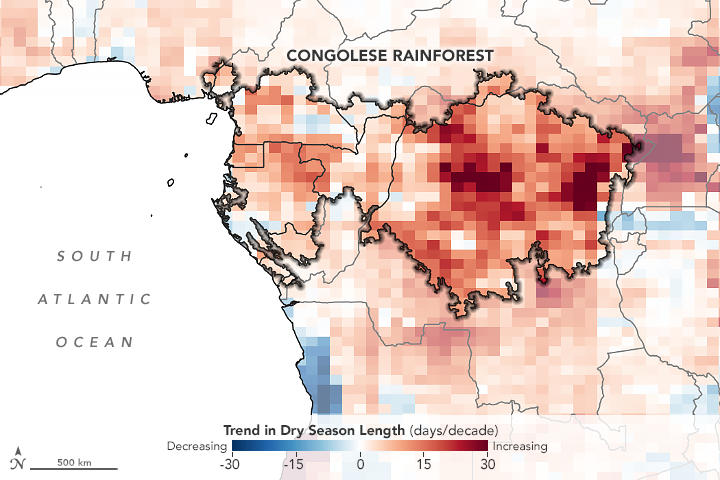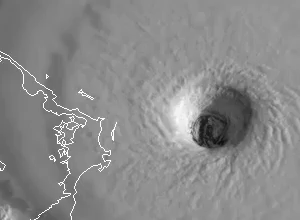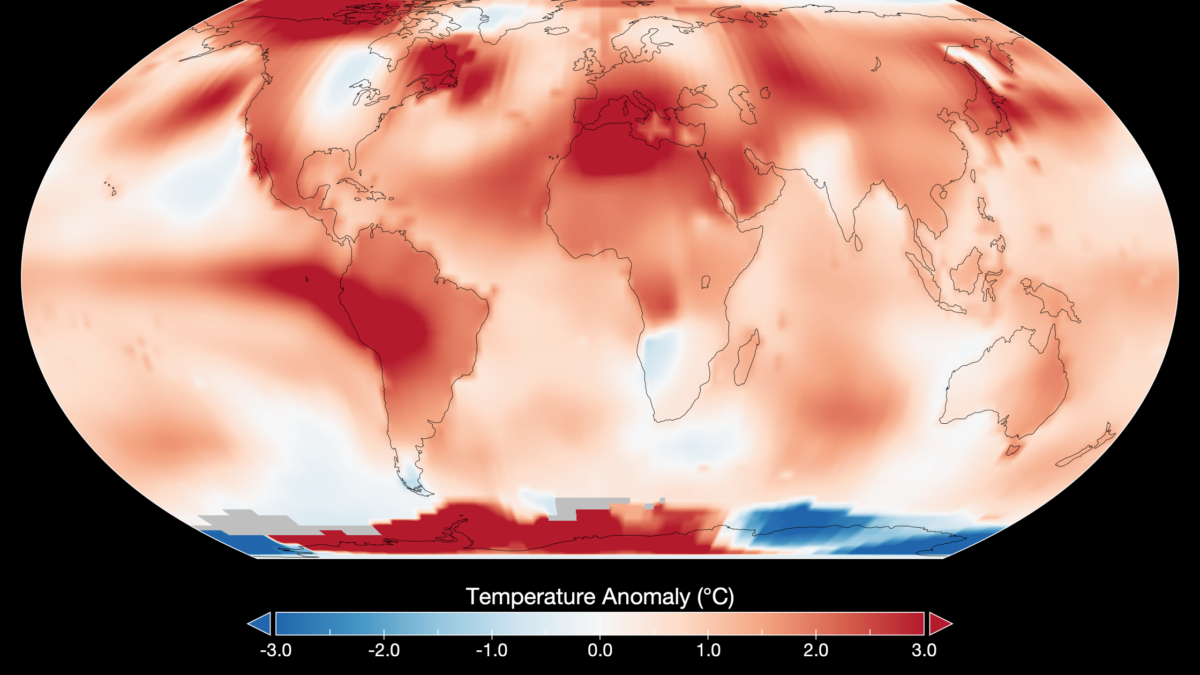A longer dry season in the Congo Rainforest – “Dry season length is one of the most crucial climate limitations for sustaining rainforest”

By Kathryn Hansen
3 July 2019
(NASA) – It is the “rain” in the term “rainforest” that makes possible the diverse ecosystem teeming with plants and animals.
That doesn’t mean a rainforest is always wet: tropical rainforests are known for having distinct wet and dry seasons. But new research shows that the summer dry season in the Congolese rainforest of central Africa is growing longer.
The widespread lengthening of the dry season is visible in this map, which shows the number of days per decade by which the dry season has grown longer (red) or shorter (blue) between 1980 and 2015. It is based on analysis of NASA’s MERRA-2 precipitation dataset of the Global Modeling and Assimilation Office (GMAO). Within the rainforest boundaries the dry season has lengthened by about 10 days per decade. Similar changes were also observed in other precipitation and satellite-based vegetation datasets.
The Congo rainforest’s dry season is seeing changes at both ends of the boreal summer from June through August. Droughts between April and June are causing the dry season to start sooner. And without a replenishment of soil moisture, the dry season is ending later, which postpones the start of the next wet season and hinders vegetation regrowth.
“Dry season length is one of the most crucial climate limitations for sustaining rainforest,” said Liming Zhou, an atmospheric scientist at University at Albany and co-author of the paper. “It strongly influences tropical rainforest vegetation structure and composition. Any large changes that modify the rainforest’s dry season length and intensity can potentially influence the tropical rainforest’s photosynthesis and productivity.”
Zhou noted that if the dry season continues to lengthen, the Congo’s current vegetation could be replaced by species that are more tolerant of drought. For instance, evergreen forests could transition into savannas or woody grasslands—ecosystems that favor drier conditions.
Such a transition would further accelerate climate change, Zhou said. That’s because vegetation in the Congo—the second-largest rainforest in the world—is an important carbon sink. Lose that rainforest area and you lose vegetation that is important for absorbing carbon dioxide from the atmosphere.
According to Yan Jiang, a graduate student at University at Albany and the study’s lead author, longer dry seasons have also been observed in the Amazon Basin—home to the largest tropical rainforest on Earth. By comparison, the Congo rainforest is, on average, much drier than the tropical rainforests in South America and Southeast Asia. That likely makes the Congo that much more water-limited during the dry season and even more sensitive to changes in rainfall patterns.
A Longer Dry Season in the Congo Rainforest
ABSTRACT: Dry season length strongly influences tropical rainforest vegetation and is largely determined by precipitation patterns1,2. Over the Amazon, the dry season length has increased since 1979 and severe short-term droughts have occurred3,4. However, similar changes have not been investigated for the world’s second largest rainforest, the Congo Basin, where long-term drying and large-scale declines in forest greenness and canopy water content were reported5. Here we present observational evidence for widespread increases in the boreal summer (June–August) dry season length over the Congo Basin since the 1980s, from both hydrological and ecological perspectives. We analysed both dry season onset and dry season end via multiple independent precipitation and satellite-derived vegetation datasets for the period 1979–2015. The dry season length increased by 6.4–10.4 days per decade in the period 1988–2013, primarily attributed to an earlier dry season onset and a delayed dry season end. The earlier dry season onset was caused by long-term droughts due to decreased rainfall in the pre-dry season (April–June). The delayed dry season end resulted from insufficiently replenished soil moisture, which postpones the start of the next wet season and hinders vegetation regrowth. If such changes continue, the enhanced water stress in a warming climate may affect the carbon cycle and alter the composition and structure of evergreen rainforest1,6.
Widespread increase of boreal summer dry season length over the Congo rainforest


